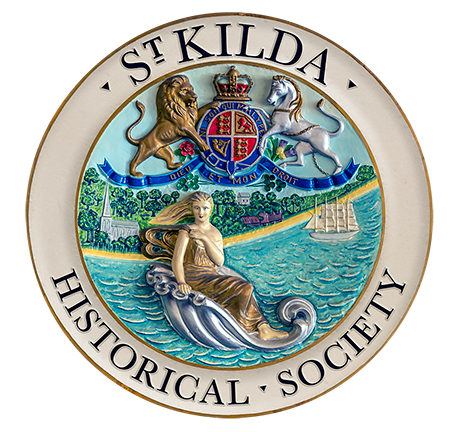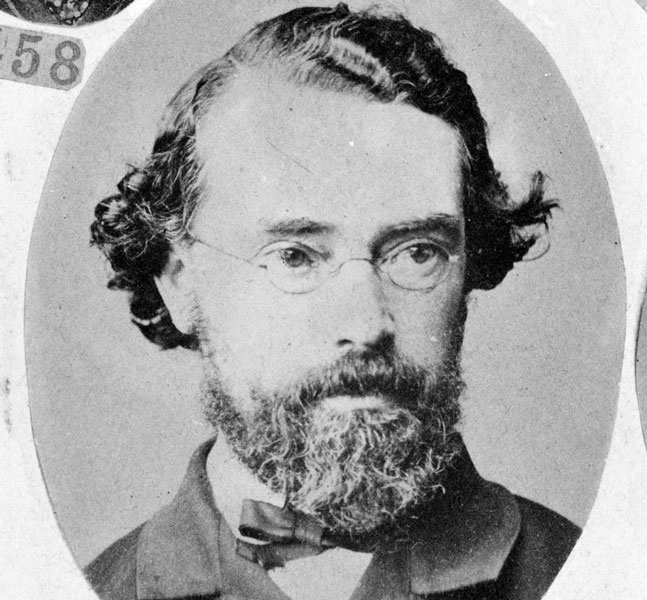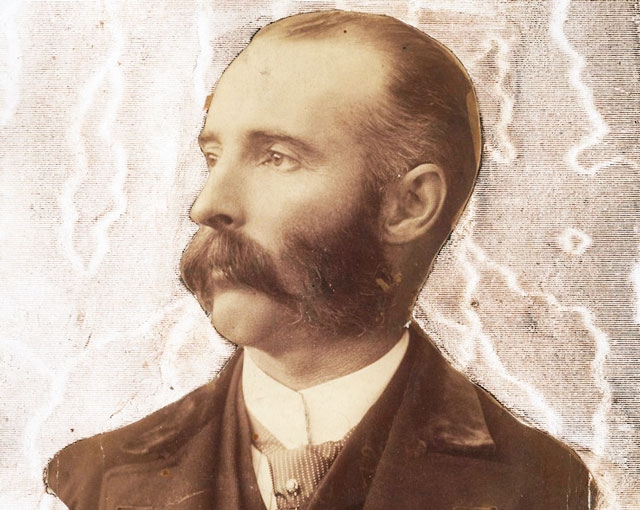In this area you will find a collection of short histories about various St Kilda identities.
William Wilkinson Wardell
An early resident of St Kilda, William Wilkinson Wardell was a prominent architect and public servant, born at Poplar, London, in 1823.
He arrived in Melbourne from England in 1858, becoming the first Fellow of the Royal Institute of British Architects to practice in Australia.
Shortly after their arrival, Wardell and his family became the first residents of the early mansion, Dulquhurn, on Dandenong Road at St Kilda East. The house is still in existence, but now forms part of the Ardoch apartment development, which comprises the former Dulquhurn, and other buildings constructed in the 1920's, 1930's and 1990's. At one stage in the 1970's and 80's it was the home of Ardoch High School.
On 7 March 1859 Wardell was appointed inspecting clerk of works for Victoria, and was promoted to Inspector-General of Works in 1861, making him responsible for the construction of all public buildings in the state. These included Government House, the Royal Mint, the Treasury, the General Post Office, and Customs House.
But his private practice led to his most outstanding work, including St Patrick’s Cathedral in Melbourne, and later St Mary’s Cathedral in Sydney. He also designed St Mary’s Cathedral in Hobart, but it had to be demolished due to faulty foundations, the responsibility of a local builder!
Closer to home, Wardell also designed his largest parish church, St Ignatius at Richmond in Melbourne, and his own local church, St Mary’s on Dandenong Road at St Kilda East, adjacent to Ardoch. His likeness can be found depicted in a stained-glass window at the west end of the south aisle of St Marys church. It was donated during a restoration of the church in 1984, by his granddaughter Teresa Mary Wardell who was a leading figure in catholic social welfare provision in Melbourne during the mid-20th century.
Wardell died in Sydney, on 19th November 1899.
Vida Goldstein
Vida Goldstein 1869-1949
Vida spent her most intellectually formative years while she was a teacher in St Kilda in the 1890s.
Michaelis, Frederick
The Michaelis family were one of the most notable Jewish families in St Kilda . One members of the family, Moritz Michaelis, lived in Linden in Acland Street which now houses the City of Port Phillip's regular art exhibitions. His brother, Frank lived in Robe street in a house called 'Orwell'. Frank's son Archie was an MLA for the St Kilda area. Some of their story is in the article below.
Rupert Bunny Artist (B 29-09-1864 D 26-5-1947)
Rupert Charles Wolston Bunny was born in Inkerman Street, St. Kilda in1864 in a house called 'Eckerberg' named after his German mother's home in Frankfurt-an-Oder. As a child Bunny became familiar, through his father, with the languages, literature, gods and goddesses of classical times. Education and liking confirmed this taste.
The Forefunners c 1894, was considered the most important aquisition for the City of St Kilda and was the primary item insured when it was largely destroyed in the Town Hall fire in 1991. The insurance funds became the source for the Rupert Bunny Foundation in 2005 which aims to support comtemporary visual artists.
Samuel and Henry Bawtree
Samuel Bawtree was one of the early purchasers of land in the St Kilda East area. He was the first owner of Marlton House.
Information provided by Peter Johnson
Samuel Jackson (1806 -1876)
George Walton's article about architect Samuel Jackson, one of Melbourne's pioneer architects, from The Argus (Melbourne, Vic: 1848 - 1957), Saturday 10 January 1931, page 7.
Dora Hallenstein de Beer (1891-1982)
Dora the Explorer - and mountaineer, photographer, author, philanthropist, ethnologist and anthropologist.
Compiled by Liz Kelly
Dora Violet de Beer (1879-1965)
Founding member of the Lyceum Club and supporter of the Arts, Dora de Beer made a considerable contribution to Melbourne’s intellectual and artistic life in the early 20th century, particularly involving herself with organisations which furthered opportunities for women.
Count and Countess de Chabrillan
Count Lionel Moreton de Chabrillan (1818-1858) French Consul and Celeste de Chabrillan (1824-1909) actress, author and diarist, lived in Hotham Street, East St Kilda.
Stanley Melbourne Bruce (1883-1967)
Stanley Melbourne Bruce, born in St Kilda, was Australia's eighth Prime Minister from 1923 to 1929.
Alfred Deakin 1856-1919
Alfred Deakin was Australia’s second Prime Minister; a position he served on three occasions - September 1903 to April 1904, July 1905 to November 1908 and June 1909 to April 1910, During the last decade of the 19th century he devoted his attention to the federation of Australian states which was achieved in 1901. Long before his parliamentary fame he was a resident of Marlton Crescent St Kilda......
Liz Kelly - March 2021
David Seddon (Rev) and Mary Green
.David Seddon arrived in Australia in 1848 to lead the first congregation at Christ Church, Acland Street St Kilda. He came with a dark history which has been provided to the Society by a contributor from Engand who has been investigating the Rev David Seddon and exploring his history by way of court transcripts. This sordid history has been collororated by work done by Liz Kelly confirming that in in 1868 he was again suddenly forced to depart- this time for England due to further accusations of misbehaviour........
Jeffrey Stafford, the author, submitted this story from England.
James Groom Short
James Groom Short was a Suffolk-born tinsmith who arrived at Port Phillip with his wife and daughter on 11 December 1850. His success running a tinsmith store alongside a business run by his wife in Nelson Street St Kilda enabled him to become a land speculator. His history of convictions and litigation in England was however repeated in Melbourne. His ownership of land in Fitzroy Street left a lasting legacy whilst his his colourful identiy was as colourful as anything the twentieth century could produce.....
by Ken Norling 2022
Julie Millowick: Highlights of collection SKHS
During the recent Covid lockdowns in Melbourne, Julie Millowick kindly donated a huge collection of images of St Kilda to the SKHS. The images give us insight into the social history of the St Kilda area during the 1970's...........
Kate Johnson (1858-1878)
While living at St Kilda's Etloe Hall (Oberwyl) with her parents, young Kate Johnson attracted the attention of Melbourne Punch magazine for her cross-dressing escapade. And became an instant media sensation. Was she St Kilda's first celebrity?
By Ken Norling. Images courtesy National Library of Australia
James Henry Fox (Born 1827 died 1900)
James Henry Fox came to Australia from England and built his career as an architect mainly in and around the township of Hamilton in the Western District where we can confirm him as being the architect for at least two significant grand homes in that area: Chatsworth House and Werribee Park (with Mr. P. Colquhoun - chief designer). His work on these buildings is largely unacknowledged though there seems little doubt from the testimonials and information collected by the Society and recorded below. It appears he may have done some further work in the St Kilda area where he died at the age of 73 years and is buried in the St Kilda Cemetery.
James Henry Fox England 1827 DOB Died 1900 and was buried in the St Kilda Cemetery departing from 101 Chapel Street St Kilda.(cnr Pakington Street and Chapel Street). Wife Matilda. One daughter: Juanita Evelyn DESAXE nee Fox
David Moore (1824-1898)
David Moore was a prominent business man of considerable wealth and property and Member of the first Parliament of Victoria, where he was a firm advocate of free trade policy.
John T Collins (1907-2001)
John T Collins (1907–2001) was an art teacher and honorary photographer for the Victorian division of the National Trust of Australia for many years. His collection of almost 20,000 black-and-white negatives has been digitised and is available online via State Library Victoria catalogue. Ranging in date from 1950 to 1988, the photographs provides a unique visual record of Victoria's architectural heritage.
David Rosenthal
David Rosenthal, a Polish migrant who arrived in Melbourne in 1852, built the successful jewellry business Rosenthal, Aronson & Company.
Freddie McEvoy (1907-1951)
Freddie McEvoy, born in St Kilda, was the first Australian to win a medal at a Winter Olympics
Robert Bennett (1822-1891)
Robert Bennett, stonemason, Melbourne Mayor, and member of Victorian Parliament, was born at Tandragee, Armagh, Northern Ireland in ca. 1822. He lived at Tandragee, 17-27 Fitzroy Street, St Kilda from 1853 until 1864.
John Barter Bennett (1824?-1887)
John Bennett, attorney, owned Tandragee, 17-27 Fitzroy Street St Kilda from 1864-1869.
William Shiels (1843-1904)
William Shiels,16th Premier of Victoria, lived in Summerland Mansions from 1890-1904.
Harriet Elphinstone Dick (1852-1908)
Arriving in Melbourne in 1876, Harriet earned an income from giving swimming exhibitions, teaching swimming and entering swimming races at Captain Kenney’s St Kilda sea baths.
Article submitted by Wayne Salt 2008
Mirka Mora (1928-2018)
Mirka loved St Kilda’s raffish bohemian charm and made it her home for nearly two decades.
Clarice Lawrence (1889-1941)
Clarice Lawrence was a WW1 Army Nurse who nursed Gallipoli casualties on the Greek island Lemnos.
John Moore Cole Airey
John Moore Cole Airey was a politician, grazier and land speculator who purchased Lot 2 in St Kilda's first ever land sale in 1842.
Frederick Brooke (c1843-1884)
Frederick Brooke was a well-known St Kilda fisherman and boatman.
Frederick John Piggott (1874-1962)
Frederick Piggott was a superindendent of Police and a forensic science pioneer.
Lloyd Tayler (1830-1900)
Architect Lloyd Tayler was particularly active in St Kilda in the mid to late 19C designing several houses and mansions including 22-24 Princes Street (1856), ‘Fernacres’ (1863), ‘Marlton’ (1864), ‘Yanakie’ (1868), ‘Decomet’ (1870) ‘Hereford’ (or ‘Herford’, 1870), and ‘Pladda’ (1889).
Information from David Helms CoPP Heritage Architect
Crouch & Wilson Architects
Crouch & Wilson was established in 1857 as a partnership of Tasmanian-born Thomas J. Crouch (1833-1889) and Ralph Wilson (1827-1886) who had recently emigrated from London. They conbined to set up a prominent and distinguished architectural firm in Melbourne during the nineteenth century, designing some of St Kilda's most prestigous buildings.
William Arnott (c1820-1894)
This article, by Peter Pereyra, focuses on William Arnott, St Kilda's first circulating librarian, where he maintained his business at three different locations in High Street.
































